Tesco PLC: Information Systems and Enterprise Resource Planning Report
VerifiedAdded on 2021/01/01
|9
|2567
|330
Report
AI Summary
This report examines the use of information systems, particularly Enterprise Resource Planning (ERP), within Tesco PLC, a major multinational retailer. It explores various information system components, including hardware, software, and databases, and their roles in managing organizational data. The report details how Tesco utilizes different information systems such as transaction processing systems, management information systems, decision support systems, artificial intelligence, and online analytical processing to streamline operations and support decision-making. Furthermore, the report delves into the benefits of ERP, such as cost-effectiveness, improved reporting, and enhanced efficiency, while also providing recommendations for optimizing ERP implementation within Tesco. The study highlights the importance of information technology in managing resources, improving supply chain management, and ultimately aiding in strategic decision-making within the retail environment. The report concludes by emphasizing the significance of information systems in the overall success of Tesco PLC.
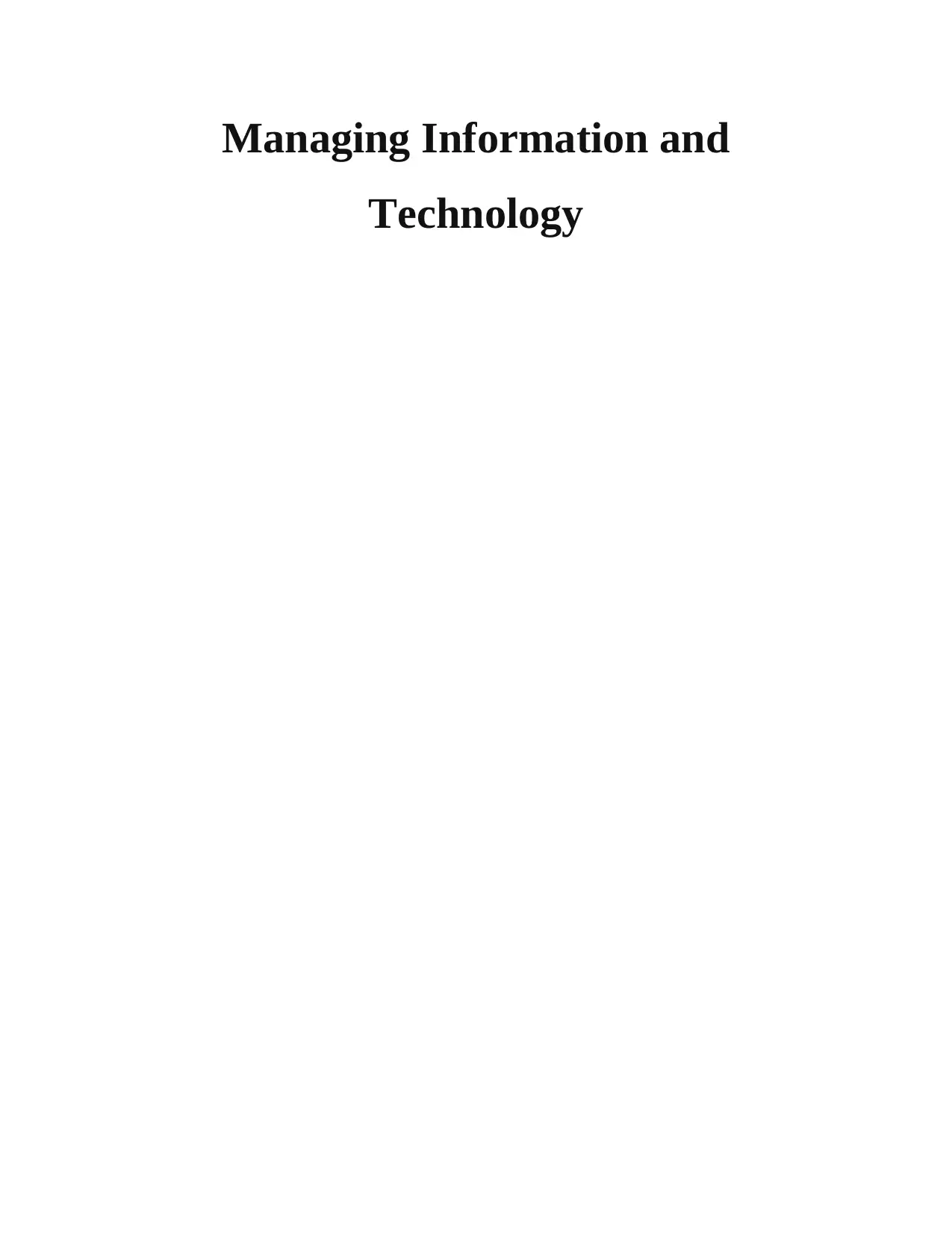
Managing Information and
Technology
Technology
Paraphrase This Document
Need a fresh take? Get an instant paraphrase of this document with our AI Paraphraser

Table of Contents
INTRODUCTION...........................................................................................................................1
MAIN BODY...................................................................................................................................1
Information System and its Components.........................................................................................1
Enterprise Resource Planning......................................................................................................3
Benefits of the Enterprise Resource Planning.............................................................................4
Recommendations for the Enterprise Resource Planning............................................................5
CONCLUSION................................................................................................................................6
REFERENCES................................................................................................................................7
INTRODUCTION...........................................................................................................................1
MAIN BODY...................................................................................................................................1
Information System and its Components.........................................................................................1
Enterprise Resource Planning......................................................................................................3
Benefits of the Enterprise Resource Planning.............................................................................4
Recommendations for the Enterprise Resource Planning............................................................5
CONCLUSION................................................................................................................................6
REFERENCES................................................................................................................................7

INTRODUCTION
Management of the Information Technology is the process to overlook the issues and
manage them efficiently to achieve the objectives of organisation In management process
business unit deals with the transferring of source internally and externally for identifying and
implementing the plans to achieve business objective. This study is for the one of the largest
retailer organization Tesco PLC. It is multinational company of Britain.
Tesco is a retailer organization which is selling groceries to the customers. This is the
third largest retailer by gross revenue and ninth largest retailer by revenue in worldwide. Its head
quarter is in Welwyn Garden city, England. This assignment will discuss about information
systems used in the organization for managing the information technology and categories of this
kind of information technology systems. Further this study is explaining the Enterprise Resource
Planning technology in the Tesco.
MAIN BODY
The Aim of the study is to study the use of information systems in the organization and
their benefits. This study also explaining the benefits of the Enterprise resource Planning and its
advantages and disadvantages. The management of the information technology helps to
organization by arrange the information in the right way to support the management to plan
better. These technologies are used by the business organisation to boost up the speed of
planning and strategy development. By use of the information system in the organisation makes
the working and operation faster and well managed.
The objective of the study is to learn the different information systems and their
categories. The other objective is to learn and explain the use of Enterprise Resource Planning in
an organisation and methods (Orna, 2017).
Information System and its Components
The information system is a technology which is used to manage the information of an
organisation. This technology used to collect the information from the different sources, put
them together to analyze the information and to generate the result which helps the management
process of organisation to take the decision and to plan resources. The information sources can
be different and this source may be from inside or outside of the organization. The main
operation of the information system is to collect the information from the different sources and
1
Management of the Information Technology is the process to overlook the issues and
manage them efficiently to achieve the objectives of organisation In management process
business unit deals with the transferring of source internally and externally for identifying and
implementing the plans to achieve business objective. This study is for the one of the largest
retailer organization Tesco PLC. It is multinational company of Britain.
Tesco is a retailer organization which is selling groceries to the customers. This is the
third largest retailer by gross revenue and ninth largest retailer by revenue in worldwide. Its head
quarter is in Welwyn Garden city, England. This assignment will discuss about information
systems used in the organization for managing the information technology and categories of this
kind of information technology systems. Further this study is explaining the Enterprise Resource
Planning technology in the Tesco.
MAIN BODY
The Aim of the study is to study the use of information systems in the organization and
their benefits. This study also explaining the benefits of the Enterprise resource Planning and its
advantages and disadvantages. The management of the information technology helps to
organization by arrange the information in the right way to support the management to plan
better. These technologies are used by the business organisation to boost up the speed of
planning and strategy development. By use of the information system in the organisation makes
the working and operation faster and well managed.
The objective of the study is to learn the different information systems and their
categories. The other objective is to learn and explain the use of Enterprise Resource Planning in
an organisation and methods (Orna, 2017).
Information System and its Components
The information system is a technology which is used to manage the information of an
organisation. This technology used to collect the information from the different sources, put
them together to analyze the information and to generate the result which helps the management
process of organisation to take the decision and to plan resources. The information sources can
be different and this source may be from inside or outside of the organization. The main
operation of the information system is to collect the information from the different sources and
1
⊘ This is a preview!⊘
Do you want full access?
Subscribe today to unlock all pages.

Trusted by 1+ million students worldwide
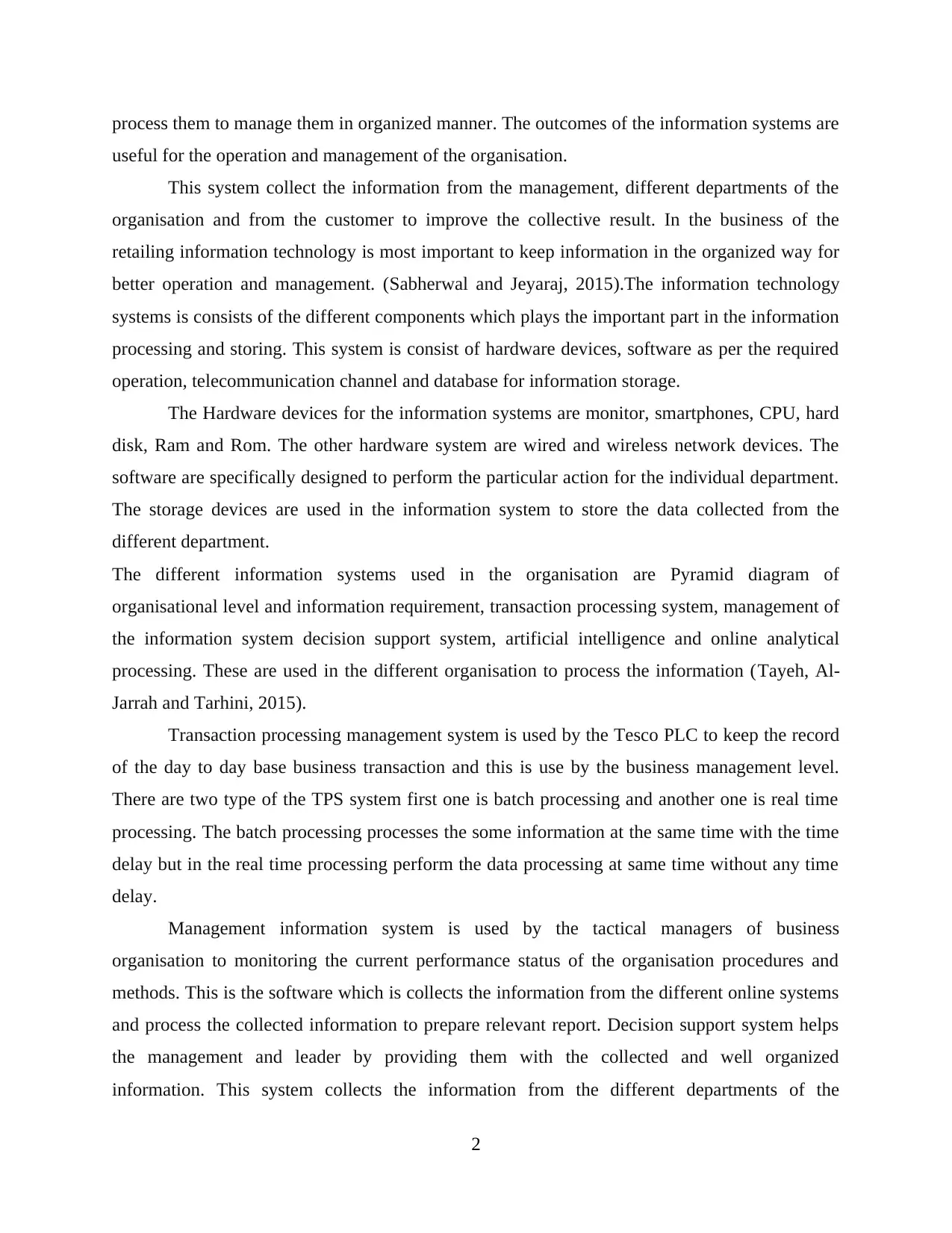
process them to manage them in organized manner. The outcomes of the information systems are
useful for the operation and management of the organisation.
This system collect the information from the management, different departments of the
organisation and from the customer to improve the collective result. In the business of the
retailing information technology is most important to keep information in the organized way for
better operation and management. (Sabherwal and Jeyaraj, 2015).The information technology
systems is consists of the different components which plays the important part in the information
processing and storing. This system is consist of hardware devices, software as per the required
operation, telecommunication channel and database for information storage.
The Hardware devices for the information systems are monitor, smartphones, CPU, hard
disk, Ram and Rom. The other hardware system are wired and wireless network devices. The
software are specifically designed to perform the particular action for the individual department.
The storage devices are used in the information system to store the data collected from the
different department.
The different information systems used in the organisation are Pyramid diagram of
organisational level and information requirement, transaction processing system, management of
the information system decision support system, artificial intelligence and online analytical
processing. These are used in the different organisation to process the information (Tayeh, Al-
Jarrah and Tarhini, 2015).
Transaction processing management system is used by the Tesco PLC to keep the record
of the day to day base business transaction and this is use by the business management level.
There are two type of the TPS system first one is batch processing and another one is real time
processing. The batch processing processes the some information at the same time with the time
delay but in the real time processing perform the data processing at same time without any time
delay.
Management information system is used by the tactical managers of business
organisation to monitoring the current performance status of the organisation procedures and
methods. This is the software which is collects the information from the different online systems
and process the collected information to prepare relevant report. Decision support system helps
the management and leader by providing them with the collected and well organized
information. This system collects the information from the different departments of the
2
useful for the operation and management of the organisation.
This system collect the information from the management, different departments of the
organisation and from the customer to improve the collective result. In the business of the
retailing information technology is most important to keep information in the organized way for
better operation and management. (Sabherwal and Jeyaraj, 2015).The information technology
systems is consists of the different components which plays the important part in the information
processing and storing. This system is consist of hardware devices, software as per the required
operation, telecommunication channel and database for information storage.
The Hardware devices for the information systems are monitor, smartphones, CPU, hard
disk, Ram and Rom. The other hardware system are wired and wireless network devices. The
software are specifically designed to perform the particular action for the individual department.
The storage devices are used in the information system to store the data collected from the
different department.
The different information systems used in the organisation are Pyramid diagram of
organisational level and information requirement, transaction processing system, management of
the information system decision support system, artificial intelligence and online analytical
processing. These are used in the different organisation to process the information (Tayeh, Al-
Jarrah and Tarhini, 2015).
Transaction processing management system is used by the Tesco PLC to keep the record
of the day to day base business transaction and this is use by the business management level.
There are two type of the TPS system first one is batch processing and another one is real time
processing. The batch processing processes the some information at the same time with the time
delay but in the real time processing perform the data processing at same time without any time
delay.
Management information system is used by the tactical managers of business
organisation to monitoring the current performance status of the organisation procedures and
methods. This is the software which is collects the information from the different online systems
and process the collected information to prepare relevant report. Decision support system helps
the management and leader by providing them with the collected and well organized
information. This system collects the information from the different departments of the
2
Paraphrase This Document
Need a fresh take? Get an instant paraphrase of this document with our AI Paraphraser
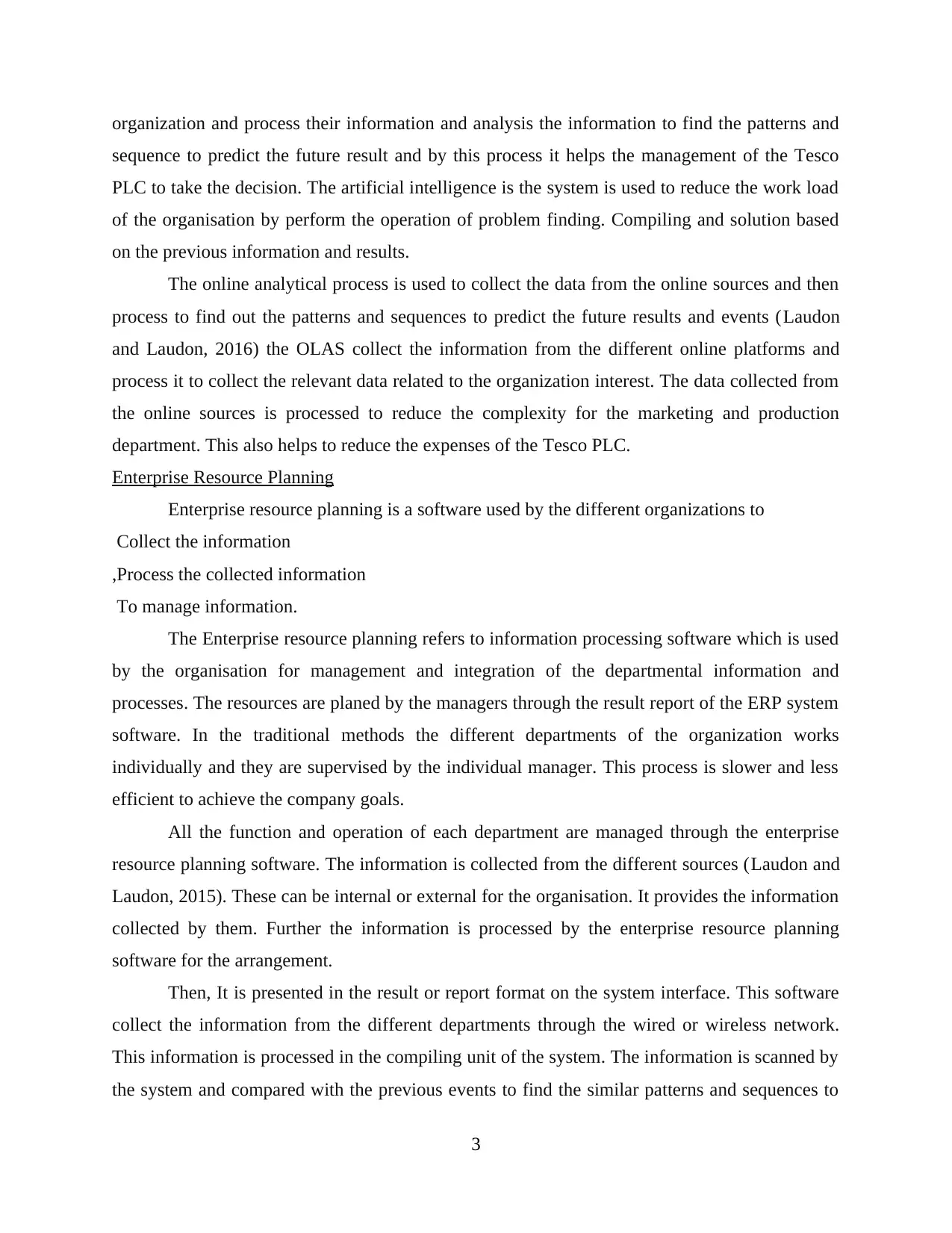
organization and process their information and analysis the information to find the patterns and
sequence to predict the future result and by this process it helps the management of the Tesco
PLC to take the decision. The artificial intelligence is the system is used to reduce the work load
of the organisation by perform the operation of problem finding. Compiling and solution based
on the previous information and results.
The online analytical process is used to collect the data from the online sources and then
process to find out the patterns and sequences to predict the future results and events (Laudon
and Laudon, 2016) the OLAS collect the information from the different online platforms and
process it to collect the relevant data related to the organization interest. The data collected from
the online sources is processed to reduce the complexity for the marketing and production
department. This also helps to reduce the expenses of the Tesco PLC.
Enterprise Resource Planning
Enterprise resource planning is a software used by the different organizations to
Collect the information
,Process the collected information
To manage information.
The Enterprise resource planning refers to information processing software which is used
by the organisation for management and integration of the departmental information and
processes. The resources are planed by the managers through the result report of the ERP system
software. In the traditional methods the different departments of the organization works
individually and they are supervised by the individual manager. This process is slower and less
efficient to achieve the company goals.
All the function and operation of each department are managed through the enterprise
resource planning software. The information is collected from the different sources (Laudon and
Laudon, 2015). These can be internal or external for the organisation. It provides the information
collected by them. Further the information is processed by the enterprise resource planning
software for the arrangement.
Then, It is presented in the result or report format on the system interface. This software
collect the information from the different departments through the wired or wireless network.
This information is processed in the compiling unit of the system. The information is scanned by
the system and compared with the previous events to find the similar patterns and sequences to
3
sequence to predict the future result and by this process it helps the management of the Tesco
PLC to take the decision. The artificial intelligence is the system is used to reduce the work load
of the organisation by perform the operation of problem finding. Compiling and solution based
on the previous information and results.
The online analytical process is used to collect the data from the online sources and then
process to find out the patterns and sequences to predict the future results and events (Laudon
and Laudon, 2016) the OLAS collect the information from the different online platforms and
process it to collect the relevant data related to the organization interest. The data collected from
the online sources is processed to reduce the complexity for the marketing and production
department. This also helps to reduce the expenses of the Tesco PLC.
Enterprise Resource Planning
Enterprise resource planning is a software used by the different organizations to
Collect the information
,Process the collected information
To manage information.
The Enterprise resource planning refers to information processing software which is used
by the organisation for management and integration of the departmental information and
processes. The resources are planed by the managers through the result report of the ERP system
software. In the traditional methods the different departments of the organization works
individually and they are supervised by the individual manager. This process is slower and less
efficient to achieve the company goals.
All the function and operation of each department are managed through the enterprise
resource planning software. The information is collected from the different sources (Laudon and
Laudon, 2015). These can be internal or external for the organisation. It provides the information
collected by them. Further the information is processed by the enterprise resource planning
software for the arrangement.
Then, It is presented in the result or report format on the system interface. This software
collect the information from the different departments through the wired or wireless network.
This information is processed in the compiling unit of the system. The information is scanned by
the system and compared with the previous events to find the similar patterns and sequences to
3

predict the future occurrence and event. Then finally the processed data is presented as result.
This data helps the organisation managers and leader to take the decisions for business
improvement (Mu, Kirsch and Butler, 2015).
In the ERP the information sources are the different departments of the Tesco PLC.
These departments are production, human resources' management, operation, sales and
marketing , research and development, purchasing department, information technology,
distribution department, customer support department, finance, social media. This mentioned
department collect their individual information to process.
The Enterprise Resource Planning collect the information from the company parts. The
different departments have their own information processing software which are designed as the
individual need of the department (Tian and Xu, 2015). The software of the finance department
is designed for the calculation and management of the funds, software used by the HRM is based
on the information collected form the employee life cycle. The production and operation
department software are based on supplies and production line. This how the individual
departmental software works.
The Enterprise resource planning system connect all the different software of Tesco PLC
and show the information details on the interface screen. The ERP collects the data and process it
to find the required result. The results and required information is stored in the storage for the
further use. Through the information system the management of resources and supply chain is
way easier. The information system allows the Tesco to track the information of the inventory
and customer which can be helpful to change the strategy of business or for future planning.
This is how the information technology system helps the organization to manage the information
and supports in decision making (Antero, 2015).
Benefits of the Enterprise Resource Planning
Cost Effective
Enterprise Resource Planning is a computer software which represents the information of
different departments on the single interface. The installation cost of the ERP is not too much,
the companies can reduce the cost by implementation of this information system. This system
can reduces the cost by reducing the man power used for the management of the information.
Total Visibility
4
This data helps the organisation managers and leader to take the decisions for business
improvement (Mu, Kirsch and Butler, 2015).
In the ERP the information sources are the different departments of the Tesco PLC.
These departments are production, human resources' management, operation, sales and
marketing , research and development, purchasing department, information technology,
distribution department, customer support department, finance, social media. This mentioned
department collect their individual information to process.
The Enterprise Resource Planning collect the information from the company parts. The
different departments have their own information processing software which are designed as the
individual need of the department (Tian and Xu, 2015). The software of the finance department
is designed for the calculation and management of the funds, software used by the HRM is based
on the information collected form the employee life cycle. The production and operation
department software are based on supplies and production line. This how the individual
departmental software works.
The Enterprise resource planning system connect all the different software of Tesco PLC
and show the information details on the interface screen. The ERP collects the data and process it
to find the required result. The results and required information is stored in the storage for the
further use. Through the information system the management of resources and supply chain is
way easier. The information system allows the Tesco to track the information of the inventory
and customer which can be helpful to change the strategy of business or for future planning.
This is how the information technology system helps the organization to manage the information
and supports in decision making (Antero, 2015).
Benefits of the Enterprise Resource Planning
Cost Effective
Enterprise Resource Planning is a computer software which represents the information of
different departments on the single interface. The installation cost of the ERP is not too much,
the companies can reduce the cost by implementation of this information system. This system
can reduces the cost by reducing the man power used for the management of the information.
Total Visibility
4
⊘ This is a preview!⊘
Do you want full access?
Subscribe today to unlock all pages.

Trusted by 1+ million students worldwide
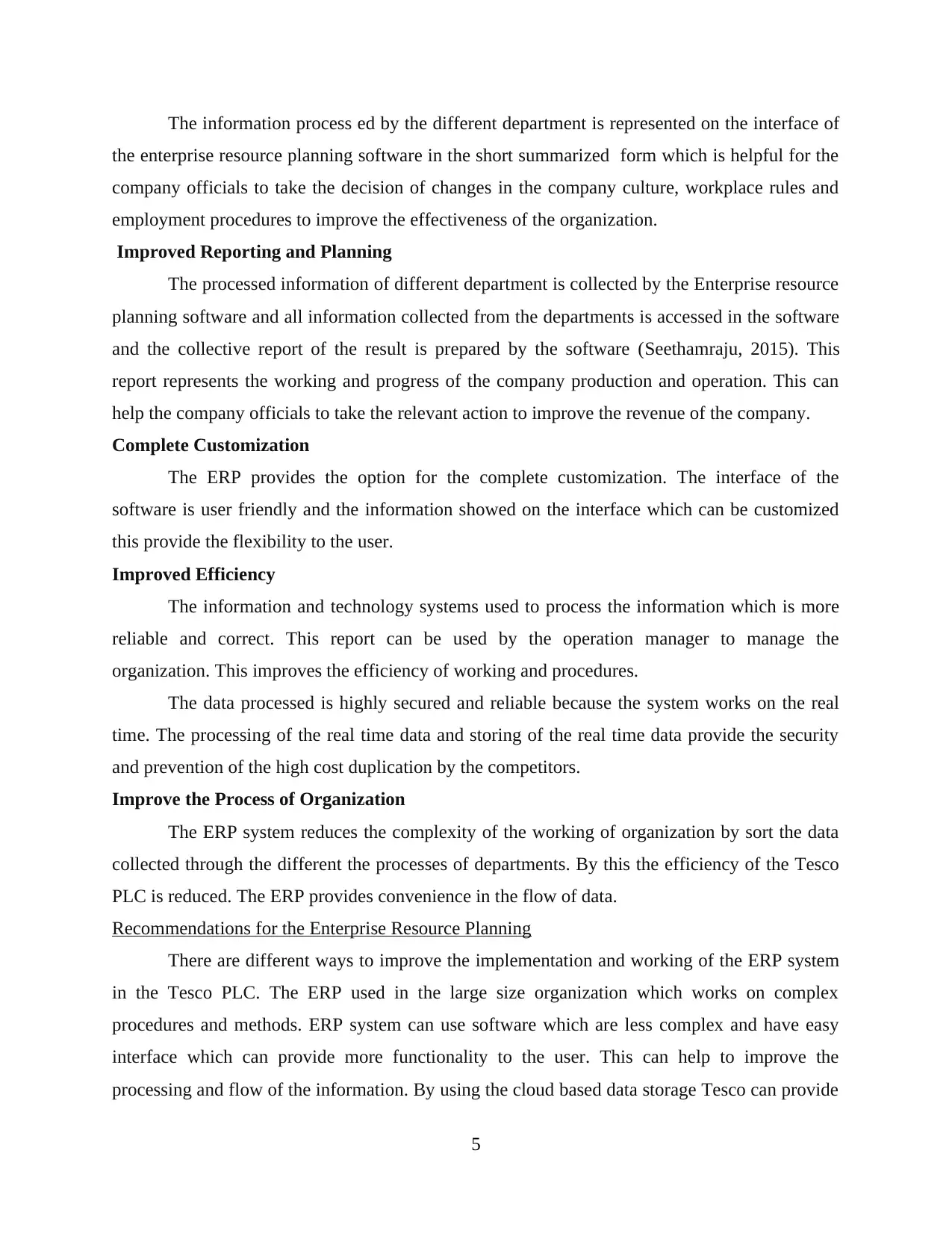
The information process ed by the different department is represented on the interface of
the enterprise resource planning software in the short summarized form which is helpful for the
company officials to take the decision of changes in the company culture, workplace rules and
employment procedures to improve the effectiveness of the organization.
Improved Reporting and Planning
The processed information of different department is collected by the Enterprise resource
planning software and all information collected from the departments is accessed in the software
and the collective report of the result is prepared by the software (Seethamraju, 2015). This
report represents the working and progress of the company production and operation. This can
help the company officials to take the relevant action to improve the revenue of the company.
Complete Customization
The ERP provides the option for the complete customization. The interface of the
software is user friendly and the information showed on the interface which can be customized
this provide the flexibility to the user.
Improved Efficiency
The information and technology systems used to process the information which is more
reliable and correct. This report can be used by the operation manager to manage the
organization. This improves the efficiency of working and procedures.
The data processed is highly secured and reliable because the system works on the real
time. The processing of the real time data and storing of the real time data provide the security
and prevention of the high cost duplication by the competitors.
Improve the Process of Organization
The ERP system reduces the complexity of the working of organization by sort the data
collected through the different the processes of departments. By this the efficiency of the Tesco
PLC is reduced. The ERP provides convenience in the flow of data.
Recommendations for the Enterprise Resource Planning
There are different ways to improve the implementation and working of the ERP system
in the Tesco PLC. The ERP used in the large size organization which works on complex
procedures and methods. ERP system can use software which are less complex and have easy
interface which can provide more functionality to the user. This can help to improve the
processing and flow of the information. By using the cloud based data storage Tesco can provide
5
the enterprise resource planning software in the short summarized form which is helpful for the
company officials to take the decision of changes in the company culture, workplace rules and
employment procedures to improve the effectiveness of the organization.
Improved Reporting and Planning
The processed information of different department is collected by the Enterprise resource
planning software and all information collected from the departments is accessed in the software
and the collective report of the result is prepared by the software (Seethamraju, 2015). This
report represents the working and progress of the company production and operation. This can
help the company officials to take the relevant action to improve the revenue of the company.
Complete Customization
The ERP provides the option for the complete customization. The interface of the
software is user friendly and the information showed on the interface which can be customized
this provide the flexibility to the user.
Improved Efficiency
The information and technology systems used to process the information which is more
reliable and correct. This report can be used by the operation manager to manage the
organization. This improves the efficiency of working and procedures.
The data processed is highly secured and reliable because the system works on the real
time. The processing of the real time data and storing of the real time data provide the security
and prevention of the high cost duplication by the competitors.
Improve the Process of Organization
The ERP system reduces the complexity of the working of organization by sort the data
collected through the different the processes of departments. By this the efficiency of the Tesco
PLC is reduced. The ERP provides convenience in the flow of data.
Recommendations for the Enterprise Resource Planning
There are different ways to improve the implementation and working of the ERP system
in the Tesco PLC. The ERP used in the large size organization which works on complex
procedures and methods. ERP system can use software which are less complex and have easy
interface which can provide more functionality to the user. This can help to improve the
processing and flow of the information. By using the cloud based data storage Tesco can provide
5
Paraphrase This Document
Need a fresh take? Get an instant paraphrase of this document with our AI Paraphraser
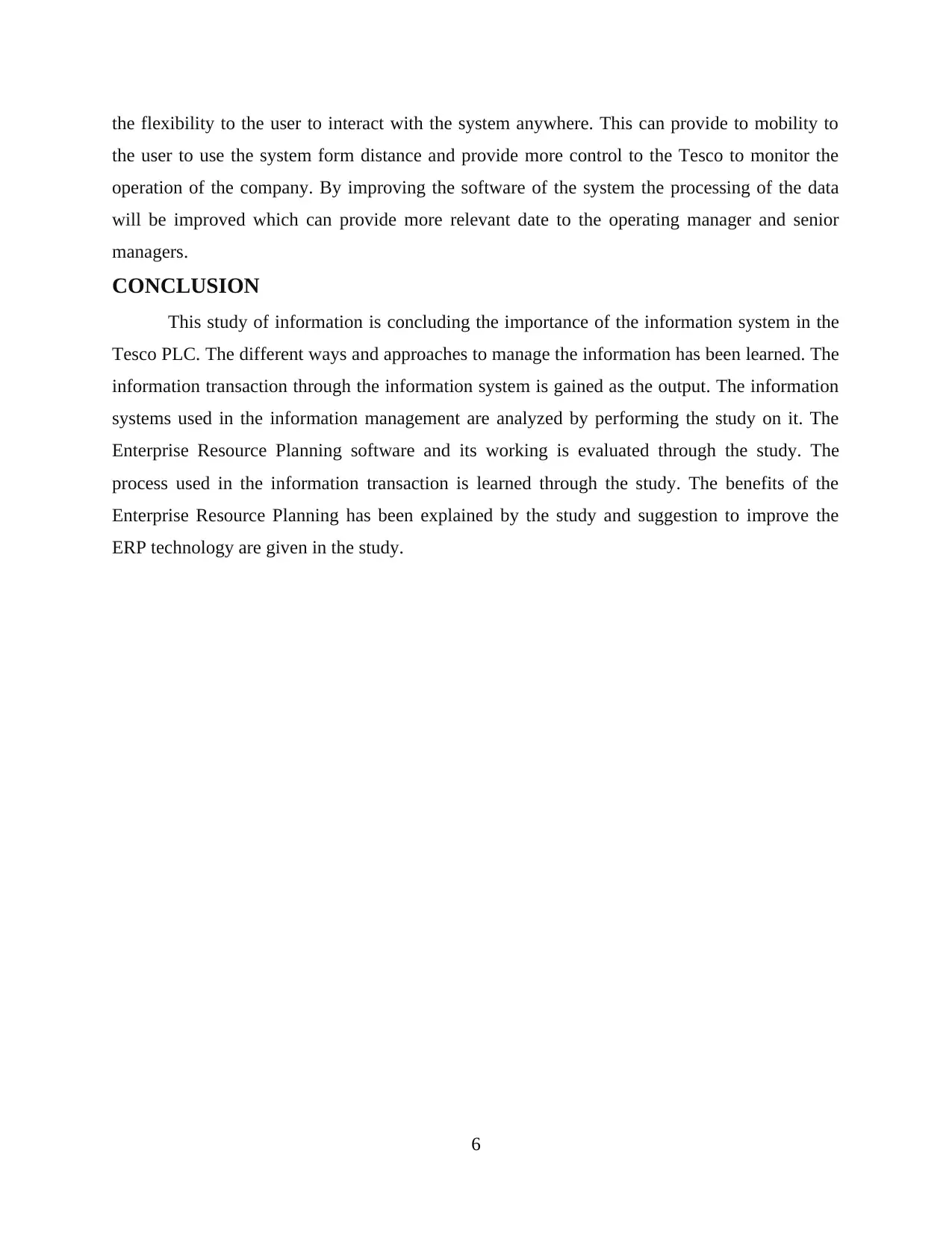
the flexibility to the user to interact with the system anywhere. This can provide to mobility to
the user to use the system form distance and provide more control to the Tesco to monitor the
operation of the company. By improving the software of the system the processing of the data
will be improved which can provide more relevant date to the operating manager and senior
managers.
CONCLUSION
This study of information is concluding the importance of the information system in the
Tesco PLC. The different ways and approaches to manage the information has been learned. The
information transaction through the information system is gained as the output. The information
systems used in the information management are analyzed by performing the study on it. The
Enterprise Resource Planning software and its working is evaluated through the study. The
process used in the information transaction is learned through the study. The benefits of the
Enterprise Resource Planning has been explained by the study and suggestion to improve the
ERP technology are given in the study.
6
the user to use the system form distance and provide more control to the Tesco to monitor the
operation of the company. By improving the software of the system the processing of the data
will be improved which can provide more relevant date to the operating manager and senior
managers.
CONCLUSION
This study of information is concluding the importance of the information system in the
Tesco PLC. The different ways and approaches to manage the information has been learned. The
information transaction through the information system is gained as the output. The information
systems used in the information management are analyzed by performing the study on it. The
Enterprise Resource Planning software and its working is evaluated through the study. The
process used in the information transaction is learned through the study. The benefits of the
Enterprise Resource Planning has been explained by the study and suggestion to improve the
ERP technology are given in the study.
6
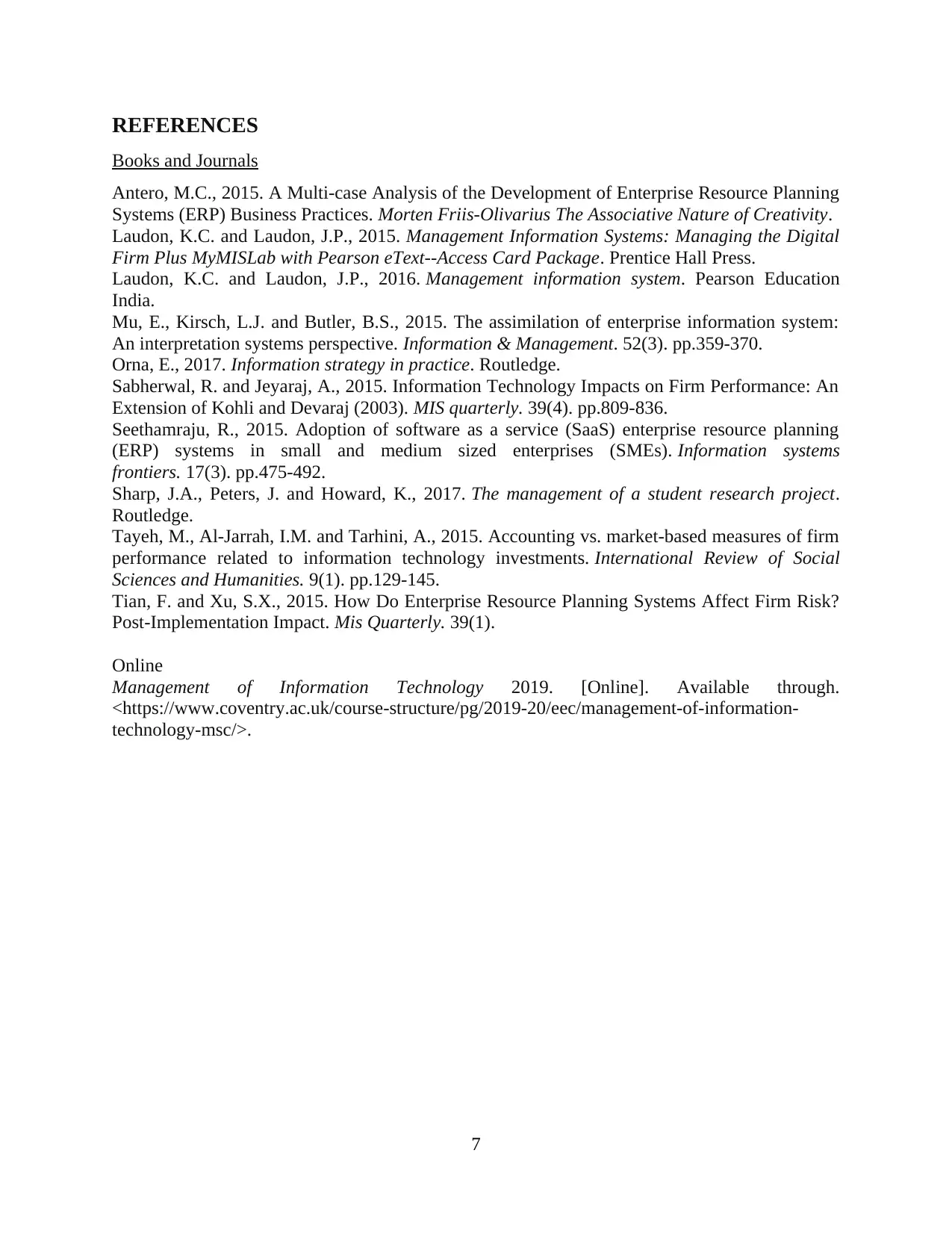
REFERENCES
Books and Journals
Antero, M.C., 2015. A Multi-case Analysis of the Development of Enterprise Resource Planning
Systems (ERP) Business Practices. Morten Friis-Olivarius The Associative Nature of Creativity.
Laudon, K.C. and Laudon, J.P., 2015. Management Information Systems: Managing the Digital
Firm Plus MyMISLab with Pearson eText--Access Card Package. Prentice Hall Press.
Laudon, K.C. and Laudon, J.P., 2016. Management information system. Pearson Education
India.
Mu, E., Kirsch, L.J. and Butler, B.S., 2015. The assimilation of enterprise information system:
An interpretation systems perspective. Information & Management. 52(3). pp.359-370.
Orna, E., 2017. Information strategy in practice. Routledge.
Sabherwal, R. and Jeyaraj, A., 2015. Information Technology Impacts on Firm Performance: An
Extension of Kohli and Devaraj (2003). MIS quarterly. 39(4). pp.809-836.
Seethamraju, R., 2015. Adoption of software as a service (SaaS) enterprise resource planning
(ERP) systems in small and medium sized enterprises (SMEs). Information systems
frontiers. 17(3). pp.475-492.
Sharp, J.A., Peters, J. and Howard, K., 2017. The management of a student research project.
Routledge.
Tayeh, M., Al-Jarrah, I.M. and Tarhini, A., 2015. Accounting vs. market-based measures of firm
performance related to information technology investments. International Review of Social
Sciences and Humanities. 9(1). pp.129-145.
Tian, F. and Xu, S.X., 2015. How Do Enterprise Resource Planning Systems Affect Firm Risk?
Post-Implementation Impact. Mis Quarterly. 39(1).
Online
Management of Information Technology 2019. [Online]. Available through.
<https://www.coventry.ac.uk/course-structure/pg/2019-20/eec/management-of-information-
technology-msc/>.
7
Books and Journals
Antero, M.C., 2015. A Multi-case Analysis of the Development of Enterprise Resource Planning
Systems (ERP) Business Practices. Morten Friis-Olivarius The Associative Nature of Creativity.
Laudon, K.C. and Laudon, J.P., 2015. Management Information Systems: Managing the Digital
Firm Plus MyMISLab with Pearson eText--Access Card Package. Prentice Hall Press.
Laudon, K.C. and Laudon, J.P., 2016. Management information system. Pearson Education
India.
Mu, E., Kirsch, L.J. and Butler, B.S., 2015. The assimilation of enterprise information system:
An interpretation systems perspective. Information & Management. 52(3). pp.359-370.
Orna, E., 2017. Information strategy in practice. Routledge.
Sabherwal, R. and Jeyaraj, A., 2015. Information Technology Impacts on Firm Performance: An
Extension of Kohli and Devaraj (2003). MIS quarterly. 39(4). pp.809-836.
Seethamraju, R., 2015. Adoption of software as a service (SaaS) enterprise resource planning
(ERP) systems in small and medium sized enterprises (SMEs). Information systems
frontiers. 17(3). pp.475-492.
Sharp, J.A., Peters, J. and Howard, K., 2017. The management of a student research project.
Routledge.
Tayeh, M., Al-Jarrah, I.M. and Tarhini, A., 2015. Accounting vs. market-based measures of firm
performance related to information technology investments. International Review of Social
Sciences and Humanities. 9(1). pp.129-145.
Tian, F. and Xu, S.X., 2015. How Do Enterprise Resource Planning Systems Affect Firm Risk?
Post-Implementation Impact. Mis Quarterly. 39(1).
Online
Management of Information Technology 2019. [Online]. Available through.
<https://www.coventry.ac.uk/course-structure/pg/2019-20/eec/management-of-information-
technology-msc/>.
7
⊘ This is a preview!⊘
Do you want full access?
Subscribe today to unlock all pages.

Trusted by 1+ million students worldwide
1 out of 9
Related Documents
Your All-in-One AI-Powered Toolkit for Academic Success.
+13062052269
info@desklib.com
Available 24*7 on WhatsApp / Email
![[object Object]](/_next/static/media/star-bottom.7253800d.svg)
Unlock your academic potential
Copyright © 2020–2025 A2Z Services. All Rights Reserved. Developed and managed by ZUCOL.




